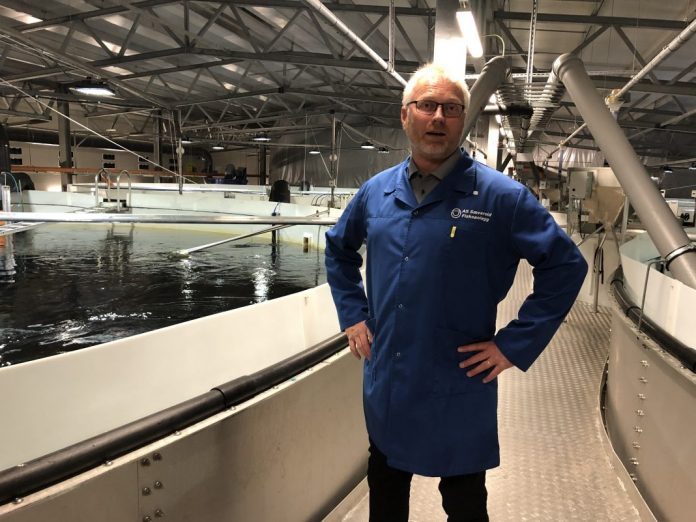After two years of improvements, Sævareid Fiskanlegg has finally formally opened its new smolt plant and recirculating system.
The mayor, shareholders and suppliers have all left. Most of the puff pastry has been eaten up. But the soup is still hot.
“We had a formal opening today after the improvements. We had a small ceremony, have informed about the construction process and what RAS is all about,” Gustav Folkestad, CEO of the smolt giant Sævareid Fiskeanlegg told SalmonBusiness.
But the new smolt plant is not completely new. “We started using it in the spring of 2017,” he said.
There has been two years of setbacks and challenges in the plant that Krüger Kaldnes has designed and Gråkjær has built.
Krüger Kaldnes has been designing the site for two years, braving setbacks and challenges in the plant, while commercial, agricultural and aquacultural building maker Gråkjær did the site.
“For Gråkjær, this has been a new project for them. We have, as you have mentioned, experienced some problems along the way, which we have solved. We have improved the tanks, and now the plant is working properly”.
“This is a new part of the industry, where politicians and civil servants believe it is very easy to close a facility. We see that it is not like that. We have also read, with you at Ilaks, the problems Salangfisk has had with its RAS plant. With recirculation, there is a lot of new things We got into some situations,” said Folkestad.

Caverns or tanks
But now Sævareid is looking ahead.
“We have been given a new zoning plan, where we have the opportunity to develop a cavern (dug out of the mountain). But whether that is what we go for, or together with our customers, we stock up on Stadion Laks, a closed tank for the farming of salmon, we have not decided yet,” he said.
Gustav Folkestad talks fast and a lot. He’s committed.
Inside the production hall, the noise level is filled by the sound of pumps that fill the tanks with fresh and clean water. In large quantities. Each vessel is 14.2 meters in diameter. They are five meters deep and hold 700 cubic meters. In the hall, there are ten vessels. About 500,000 salmon swim in each tank.

“These are 40 grams,” said Folkestad, pointing to small salmon that swim around the tank. “We produced 2,000 tonnes this year, and we can produce 4,300 tonnes”.
“The more individuals you have to feed, the harder it is to feed since you get more losers,” he explained.
Pulp Mill
The old hatchery is built on the site of an old pulp mill. The Sævareid water catchment ends here, just off a cornerstone farm. Here, Sævareid Fiskanlegg has runoff of between 600 and 700 cubic meters of water per minute. The water is taken from three lakes, the Skogseidvatnet, Henangervatnet and Gjønavatnet, where the first two have salmon farm sites. The watercourse and the three lakes are connected by channels. In the old days, before car transport and roads took over, this was an important transport route in the region.
“We started work in 2000. But then the salmon prices fell in 2001. Then Bremnes, Tombre and Linga came along, and we started planning. It wasn’t until 2015 that we started building, but have had plans ready since 2007. Tank capacity must always account for changes,” he pointed out.
Folkestad originally comes from Fredrikstad, South-East Norway, but moved to Fusa, an hour and a half car ride from Bergen, as early as 1978. He is a trained veterinarian and followed in his father’s footsteps into salmon farming.
Fully automated
Sævareid, which was established by the Holmefjord family, owner of salmon farmer Bolaks, has fully automated vaccination. The fish is handed, stunned and sent into the vaccine machines.
“We got a cake from Maskon the other day. We had vaccinated fish number 50 million with their machine,” he smiled.
A handful of employees closely monitor fish and vaccine machines. Everything must work.
“They take continuous samples, see that the fish wakes up again, some should have the six-does vaccine, some against yersinia, and then some will also be injected with Elanco’s new DNA vaccine”.


